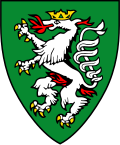The Styrian Panther
The panther, as the heraldic animal of Styria, was first definitively used in the seal of Margrave Ottokar III in 1160. It was derived from the arms of the Traungau (see Otakars) family. When Styria was made a duchy in 1180, the panther became the symbol of the entire duchy. The panther was originally black on a white field, but this was changed to the current color scheme in the 13th century in order to avoid confusion with Carantania, which at the time also used the black panther arms. [3] [4] [5]
The coat of arms was first described in detail by the chronicler Ottokar of the Gaal, who documented around 1315 how the Styrian nobility fought alongside King Ottokar II of Bohemia in 1253 against the Hungarians under King Béla IV. Ottokar's state marshal, Herrand von Wildon described the flag as
"ein banier grüene als ein gras / darin ein pantel swebte / blanc, als ob ez lebte“ [6] (a banner as green as grass / wherein a panther floated / white, as if it were alive)
In its current form, the coat of arms has been officially used since 1926 when a law restricted flames to only shoot out of the panther's mouth. [7] Prior to that flames had also emerged from the panther's ears, phallus, and anus. A member of the state parliament, Frida Mikula, sponsored the change due to the arms' apparent "obscenity".
The heraldic animal in its pre-1926 form can be seen today in the coat of arms of the Styrian capital, Graz.
Heraldic research today also points to the strong symbolic effect and the tradition of the Styrian coat of arms: “The Styrian heraldic animal has [...] become a quasi-living symbol of Styrian independence. With the possible exception of the Tyrolean eagle, no coat of arms of the Austrian federal states can match it in terms of identity. [...] The Styrian coat of arms has been in use in practically unchanged form for more than 750 years. Together with the red-white-red shield it is one of the oldest and most venerable state symbols in Europe [4] ."
This page is based on this
Wikipedia article Text is available under the
CC BY-SA 4.0 license; additional terms may apply.
Images, videos and audio are available under their respective licenses.










